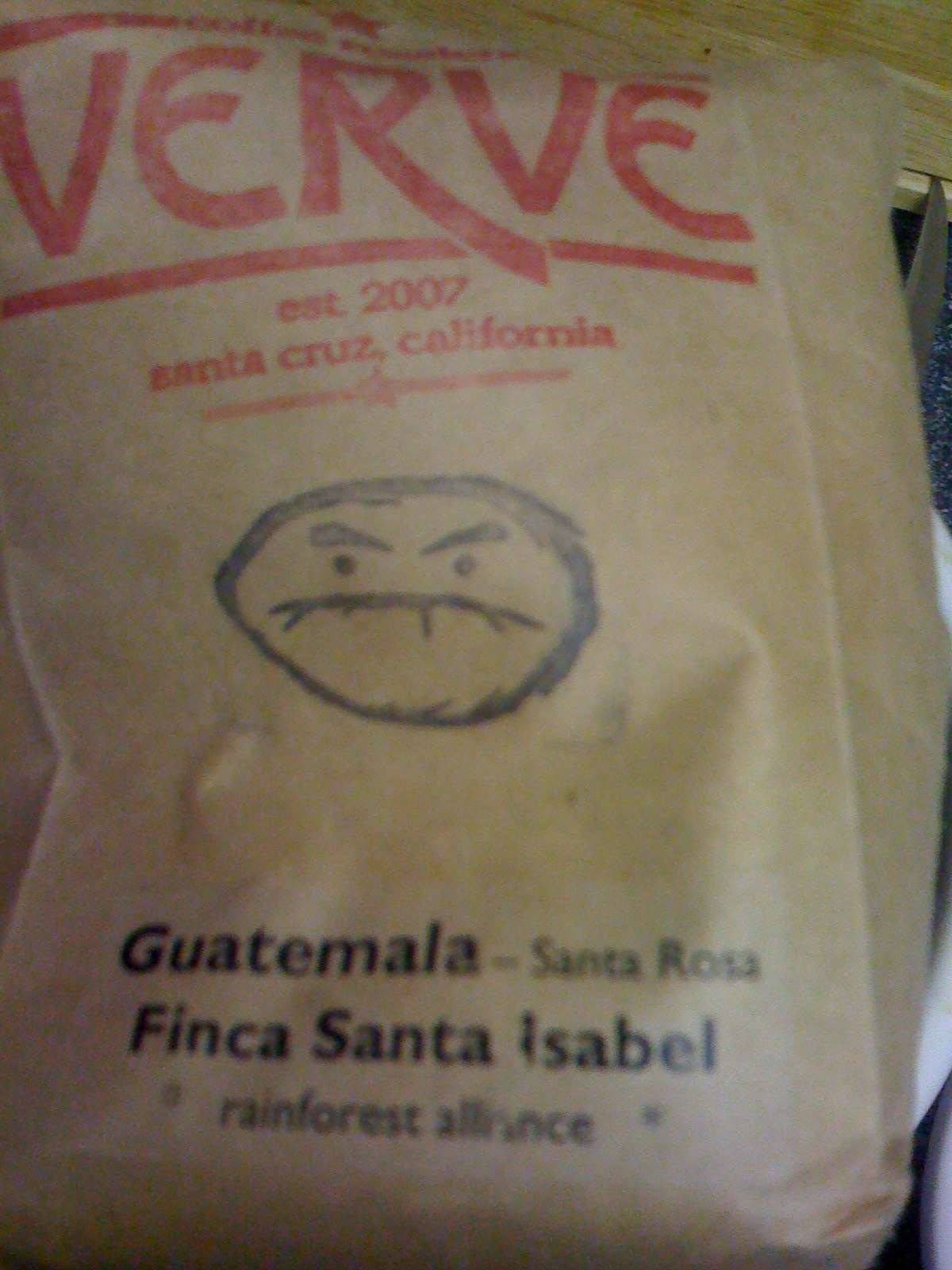 High-end culinary coffee tends to be marketed in specifically political ways. The goal may be to make the customer feel virtuous, or at least more at ease. Maybe buying a particular batch of beans will help the environment or a third-world economy. (There is an ideological divide, even in coffee, between free traders and those who advocate fair or direct trade.) When I hear "Rwanda," I think of the 1990s upheaval and genocide that left that African country in ruins. So I was curious to see this bag of beans and decided to give it a try. Rwanda's coffee industry was nearly destroyed in that era, but now is undergoing a resurgence, thanks to a chain of cooperative farms and efforts to provide simple economic tools, like bicycles.
Name: Cider Currant Spice
Origin: Nyakizu Cooperative, Byumba Provence, Zirkana, Rwanda
Roasted: Jan. 6.
Purchased: Jan. 10 at Café Grumpy, 224 W. 20th St., Manhattan, between Seventh and Eighth Avenues.
Description: Bourbon, grown at 1500 - 1900 meters above sea level.
The Pour: Quite tasty. It is a light and frothy mixture, more spice than cider, I'd say. Perfect for a snowy holiday day in New York. There's no overpowering aftertaste, and it goes down smoothly. Coffee tasters call it a "bright" cup, and I'm starting to get a sense of what they mean by that. I could drink this all day, and I just might. There was not a lot of information on the bag, although I found references elsewhere to the Nyakizu Cooperative, established in 2006. Here's a reference to the 2007 batch from this same cooperative:
High-end culinary coffee tends to be marketed in specifically political ways. The goal may be to make the customer feel virtuous, or at least more at ease. Maybe buying a particular batch of beans will help the environment or a third-world economy. (There is an ideological divide, even in coffee, between free traders and those who advocate fair or direct trade.) When I hear "Rwanda," I think of the 1990s upheaval and genocide that left that African country in ruins. So I was curious to see this bag of beans and decided to give it a try. Rwanda's coffee industry was nearly destroyed in that era, but now is undergoing a resurgence, thanks to a chain of cooperative farms and efforts to provide simple economic tools, like bicycles.
Name: Cider Currant Spice
Origin: Nyakizu Cooperative, Byumba Provence, Zirkana, Rwanda
Roasted: Jan. 6.
Purchased: Jan. 10 at Café Grumpy, 224 W. 20th St., Manhattan, between Seventh and Eighth Avenues.
Description: Bourbon, grown at 1500 - 1900 meters above sea level.
The Pour: Quite tasty. It is a light and frothy mixture, more spice than cider, I'd say. Perfect for a snowy holiday day in New York. There's no overpowering aftertaste, and it goes down smoothly. Coffee tasters call it a "bright" cup, and I'm starting to get a sense of what they mean by that. I could drink this all day, and I just might. There was not a lot of information on the bag, although I found references elsewhere to the Nyakizu Cooperative, established in 2006. Here's a reference to the 2007 batch from this same cooperative:
The coffee, an Arabica Bourbon, is grown in rich, volcanic soil at a relatively high altitude and holds onto it’s milk chocolaty tones even when roasted a bit dark. Each cup I’ve pulled has given me god-like shots, heady with crema. Other reviews I’ve read recommend the bean more for press coffee than espresso, as there is a bit of a sharp edge to the pulled shots. With a touch of velvety steamed milk, I thought the sharpness wasn’t a problem, but others might.
I wasn't picking up on the chocolate or the sharp edge with this roast, and I thought it worked fine as espresso. But here was another review:
When I first tried this coffee the blackcurrant rushing through with a light and gentle acidity. Underneath there is a hint of floral with a thick creamy body with a really clean and sharp aftertaste. I personally love these coffees in the filter and french press, a wonderfully complex coffee.
I'll have to try this as a regular filtered mug of coffee. The second link above also includes a lengthy history of how the genocide affected the coffee trade (many of those with specialized knowledge of the industry were killed). Specialty coffee sells for four times as much per kilo as regular old coffee, and with direct trade, the farmers keep more of the profits. I don't mind paying more for a good cup, and the marketing works: I get to feel slightly virtuous about a habit that is -- let's face it -- an indulgence, a luxury.

